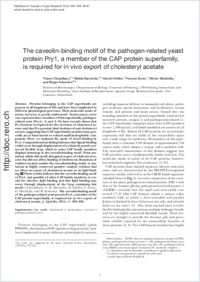The caveolin-binding motif of the pathogen-related yeast protein Pry1, a member of the CAP protein superfamily, is required for in vivo export of cholesteryl acetate
- Choudhary, Vineet Division of Biochemistry, Department of Biology, University of Fribourg, Switzerland
- Darwiche, Rabih Division of Biochemistry, Department of Biology, University of Fribourg, Switzerland
- Gfeller, David Molecular Modeling, Swiss Institute of Bioinformatics, Lausanne, Switzerland
- Zoete, Vincent Molecular Modeling, Swiss Institute of Bioinformatics, Lausanne, Switzerland
- Michielin, Olivier Molecular Modeling, Swiss Institute of Bioinformatics, Lausanne, Switzerland
- Schneiter, Roger Division of Biochemistry, Department of Biology, University of Fribourg, Switzerland
-
01.05.2014
Published in:
- Journal of Lipid Research. - 2014, vol. 55, no. 5, p. 883-894
English
Proteins belonging to the CAP superfamily are present in all kingdoms of life and have been implicated in different physiological processes. Their molecular mode of action, however, is poorly understood. Saccharomyces cerevisiae expresses three members of this superfamily, pathogen-related yeast (Pry)1, -2, and -3. We have recently shown that Pry function is required for the secretion of cholesteryl acetate and that Pry proteins bind cholesterol and cholesteryl acetate, suggesting that CAP superfamily members may generally act to bind sterols or related small hydrophobic compounds. Here, we analyzed the mode of sterol binding by Pry1. Computational modeling indicates that ligand binding could occur through displacement of a relatively poorly conserved flexible loop, which in some CAP family members displays homology to the caveolin-binding motif. Point mutations within this motif abrogated export of cholesteryl acetate but did not affect binding of cholesterol. Mutations of residues located outside the caveolin-binding motif, or mutations in highly conserved putative catalytic residues had no effect on export of cholesteryl acetate or on lipid binding. These results indicate that the caveolin-binding motif of Pry1, and possibly of other CAP family members, is crucial for selective lipid binding and that lipid binding may occur through displacement of the loop containing this motif.
- Faculty
- Faculté des sciences et de médecine
- Department
- Département de Biologie
- Language
-
- English
- Classification
- Biological sciences
- License
- License undefined
- Identifiers
-
- RERO DOC 209921
- DOI 10.1194/jlr.M047126
- Persistent URL
- https://folia.unifr.ch/unifr/documents/303717
Statistics
Document views: 134
File downloads:
- sch_cbm.pdf: 209
